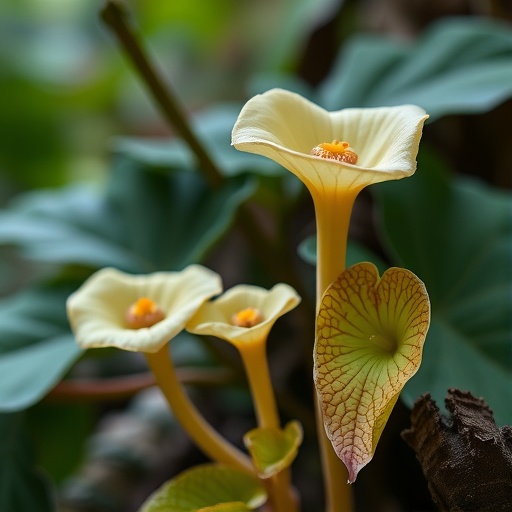A significant advancement in plant pathology has emerged from recent research exploring the toxic metabolites produced by the fungus Curvularia lunata, known to be a detrimental pathogen affecting Musa paradisiaca. This research, conducted by a team of scientists, delves into the chemical intricacies of the interactions between these organisms, using cutting-edge techniques like Gas Chromatography-Mass Spectrometry (GC-MS). The findings promise to illuminate not only the health of banana plants but also engage a broader scientific discourse about fungal metabolites and their impacts on agriculture.
Curvularia lunata is notorious for its role in the leaf spot disease affecting banana plants. As bananas are a staple food source in many regions, understanding the biochemical mechanisms that contribute to this disease is of utmost importance. The team’s research aimed to identify and analyze the specific toxic metabolites produced by this fungus when infecting Musa paradisiaca. This understanding has the potential to drive future approaches in disease management and crop protection strategies.
Utilizing GC-MS technology, the research team meticulously extracted and separated the metabolites produced by Curvularia lunata. This method, well-regarded for its precision and sensitivity, allows scientists to detect even trace amounts of chemical compounds. The GC-MS analysis revealed a plethora of volatile and semi-volatile compounds that could potentially inhibit the growth of banana plants or even induce phytotoxic effects.
One of the key aspects of the study was the identification of specific metabolites that were markedly elevated during the fungal infection process. By correlating these metabolites with the severity of the disease symptoms seen in banana plants, the researchers built a clearer picture of how Curvularia lunata influences plant health. These findings may eventually lead to more targeted and effective measures in managing and mitigating the impacts of these pathogens on agricultural yield.
Notably, the research illuminated the complexity of the interactions between the fungus and the banana plants. The identified toxic compounds not only have the potential to cause physical damage to the plant tissues but may also disrupt physiological processes. For instance, certain metabolites were found to interfere with essential plant functions such as photosynthesis and transpiration, further compounding the detrimental effects of the infection.
The revelations about the toxic metabolites produced by Curvularia lunata evoke crucial questions regarding plant defense mechanisms. How do banana plants respond to such a barrage of chemical attacks? This line of inquiry may uncover novel pathways of resistance in Musa paradisiaca, which could be pivotal for breeding programs aimed at developing resistant varieties.
Moreover, the impact of these findings extends beyond mere scientific curiosity; they hold significant implications for agricultural practices. Understanding the metabolic profile of pathogens like Curvularia lunata enables farmers and agricultural professionals to implement more informed strategies for crop management. For instance, tailored fungicidal treatments could be developed to specifically counteract the toxins produced by this fungus, thereby improving plant health and overall yield.
As global agricultural systems increasingly grapple with the challenges posed by plant diseases, insights from studies such as this one are invaluable. The comprehensive analysis conducted by the researchers not only provides a clearer understanding of Curvularia lunata but also sets a precedent for similar studies on other plant pathogens. This could ultimately contribute to a more resilient agricultural framework capable of withstanding various biotic stresses.
In terms of broader ecological significance, the interactions between fungi and plants can influence entire ecosystems. The research findings could play a role in comprehending the dynamics of soil health and biodiversity, particularly in banana cultivation regions where this pathogen is prevalent. Future studies might explore the interactions between Curvularia lunata and beneficial microorganisms that could potentially mitigate its effects.
As the agricultural community continues its battle against fungal pathogens, the research into the toxic metabolites of Curvularia lunata reminds us of the importance of a multi-faceted approach towards disease management. Innovations in biotechnology, combined with thorough biochemical understanding, may hold the key to transforming how we protect our crops and secure food supply lines.
In conclusion, the work conducted by Chowhan, Swarnakar, and Chakraborty represents a significant leap forward in our understanding of plant-pathogen interactions. The toxic metabolites identified through their research not only shed light on the mechanisms by which Curvularia lunata exerts its detrimental effects on Musa paradisiaca but also open up pathways for developing innovative solutions in combating crop diseases in the future.
Such advancements will undoubtedly continue to influence agricultural practices and plant health management, making the insights gained from this study critical for advancing sustainable agricultural systems in the face of persistent challenges posed by plant pathogens.
Subject of Research: Toxic metabolites produced by Curvularia lunata causing leaf spot disease in Musa paradisiaca
Article Title: GC MS analysis of toxic metabolites produced by Curvularia lunata causing leaf spot disease in Musa paradisiaca
Article References:
Chowhan, P., Swarnakar, S. & Chakraborty, A.P. GC MS analysis of toxic metabolites produced by Curvularia lunata causing leaf spot disease in Musa paradisiaca.
Discov. Plants 2, 328 (2025). https://doi.org/10.1007/s44372-025-00415-w
Image Credits: AI Generated
DOI: https://doi.org/10.1007/s44372-025-00415-w
Keywords: Curvularia lunata, Musa paradisiaca, toxic metabolites, leaf spot disease, plant pathology, GC-MS analysis.
Tags: agricultural research advancementsbanana plant health researchbiochemical mechanisms of fungal pathogenschemical interactions in plant-fungi relationshipsCurvularia lunata toxic metabolitesdisease management strategies for cropsfungal metabolites and agricultureGC-MS analysis in plant pathologyimpacts of fungal pathogens on food securityMusa paradisiaca leaf spot diseaseprecision techniques in metabolite detectiontoxic compounds in plant diseases





